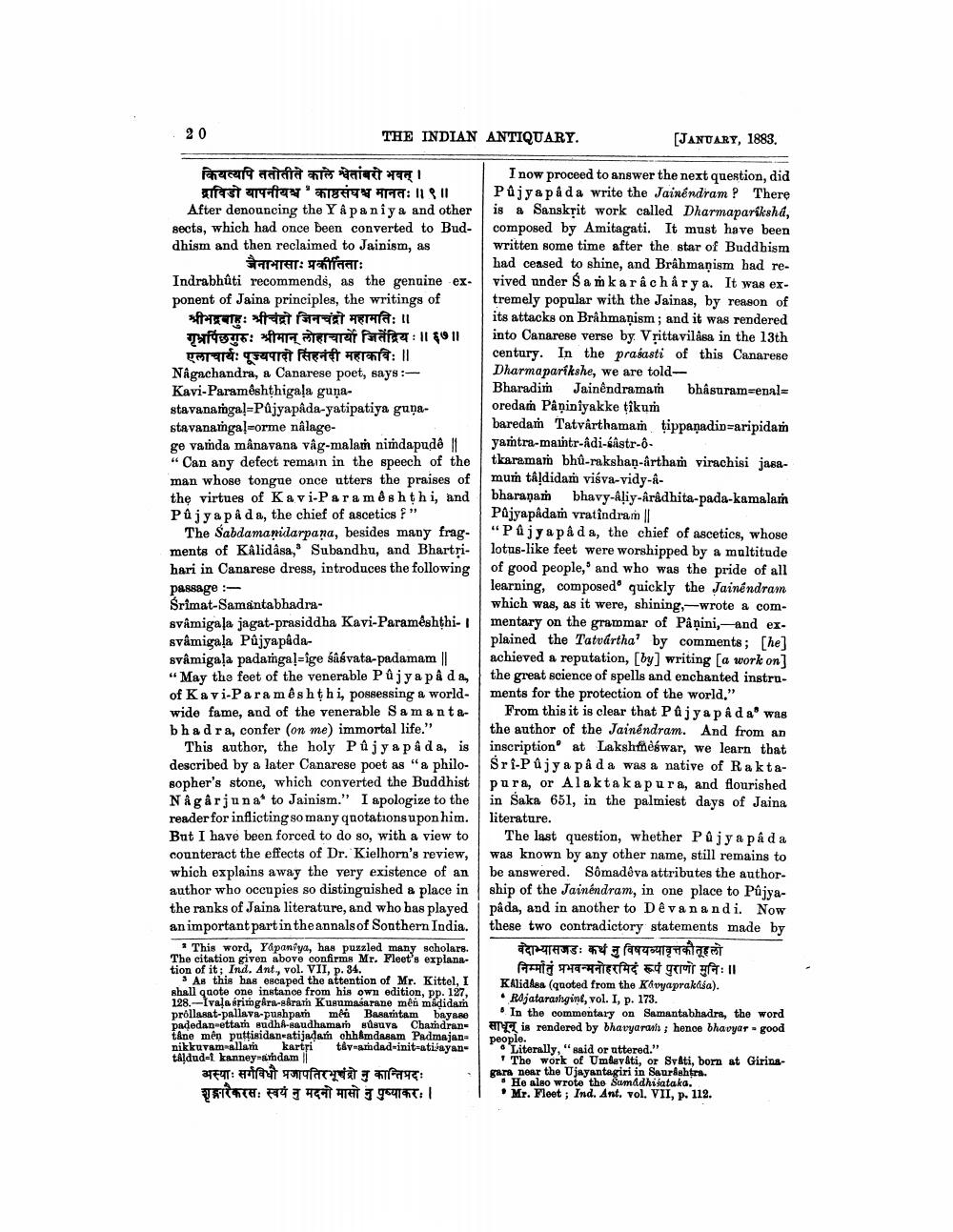________________
20
THE INDIAN ANTIQUARY.
(JANUARY, 1883
कियत्यपि ततोतीते काले श्वेतांबरी भवत् ।
I now proceed to answer the next question, did ATTET Tfter 18 HTTG:11 811 Pujyapada write the Jainéndram P There After denouncing the Y & paniya and other is a Sanskrit work called Dharmapariksha, sects, which had once been converted to Bud- composed by Amitagati. It must have been dhism and then reclaimed to Jainism, as written some time after the star of Buddhism जैनाभासाः प्रकीर्तिताः
had ceased to shine, and Brahmanism bad reIndrabhùti recommends, as the genuine ex. vived under Sankaracharya. It was exponent of Jaina principles, the writings of tremely popular with the Jainas, by reason of श्रीभद्रबाहुः श्रीचंद्रो जिनचंद्रो महामतिः।।
its attacks on Brahmanism; and it was rendered गृभ्रपिंछगुरुः श्रीमान् लोहाचार्यों जितेंद्रियः।। ६७॥ into Canarese verse by. Vrittavilåsa in the 13th एलाचार्यः पूज्यपादो सिंहनंदी महाकविः ॥
century. In the prasasti of this Canarese Nagachandra, a Canarese poet, says:
Dharmaparikshe, we are toldKavi-Paramështhigala guņa
Bharadim Jainêndramam bhâsuramenale stavanamga!=Pajyapâda-yatipatiya guna
oredam Påņiniyakke ţikum stavanamga!=orme nålage
baredam Tatvarthamam tippañadip=aripidam ge vamda månavana våg-malam nindapudô ||
malam nirdapuda 11 | yamtra-maintr-adi-bistr-. "Can any defect remain in the speech of the tkaramam bhů-rakshan-artha virachisi jasaman whose tongue once utters the praises of mum tâļdidam viśva-vidy-- the virtues of Kavi-Paramesh thi, and bharaṇam bhavy-Aliy-aradhita-pada-kamalar Půj yapada, the chief of ascetics?"
Päjyapâdam vratîndram || The Sabdamanidarpana, besides many frag. "Pujya på da, the chief of ascetics, whose ments of Kalidasa, Subandhu, and Bhartsi- lotus-like feet were worshipped by a multitude hari in Canarese dress, introduces the following of good people, and who was the pride of all passage -
learning, composed quickly the Jainêndram Srimat-Samantabhadra
which was, as it were, shining, --wrote a comsvâmigala jagat-prasiddha Kavi-Parameshthi- mentary on the grammar of Påņini, and ex. svâmigala Půjyapada
plained the Tatvartha' by comments; [he] svâmigaļa padamga!=ige sasvata-padamam || achieved a reputation, [by] writing [a work on] "May the feet of the venerable Půjya på da, the great science of spells and enchanted instruof Kavi-Para mêshthi, possessing a world- ments for the protection of the world," wido fame, and of the venerable Samanta- From this it is clear that Pujya pada was bhadra, confer (on me) immortal life." the author of the Jainéndram. And from an
This author, the holy Pajya pada, is inscription at Laksh theswar, we learn that described by a later Canarese poet as "a philo- Sri-Půjya pada was a native of Raktasopher's stone, which converted the Buddhist pora, or Alaktak apura, and flourished Nagarjuna to Jainism." I apologize to the in Saka 651, in the palmiest days of Jaina reader for inflicting so many quotations upon him. literature. But I have been forced to do so, with a view to The last question, whether Pajya pada counteract the effects of Dr. Kielhorn's review, was known by any other name, still remains to which explains away the very existence of an be answered. Sômadova attributes the authorauthor who occupies so distinguished a place in ship of the Jainéndram, in one place to Pújyathe ranks of Jaina literature, and who has played 1 pâda, and in another to Dêvanandi. Now an important part in the annals of Southern India. these two contradictory statements made by
This word, Yaponiya, has puzzled many scholars. वेदाभ्यासजडः कथं नु विषयव्यावृत्तकौतूहलो The citation given above confirms Mr. Fleet's explanation of it; Ind. Ant., vol. VII, p. 34.
निर्मातुं प्रभवन्मनोहरमिदं रूपं पुराणो मुनिः।। As this has escaped the attention of Mr. Kittel, I KAlid Asa (quoted from the Kavyapraklisa). shall quote one instance from his own edition, pp. 127, 128. --Ivala srimgåra-garam Kusumasarane mên mádidam
• Rojatarargint, vol. I, p. 173. prollanat-pallava-pushpam méi Bantam baysse
• In the commontary on Samantabhadra, the word padedan ettam budhi-saudhamam susuva Chandran Er is rendered by bhavyarasis; hence bhavyar - good Ano mên puttisidan-atijadań ohh Amdanam Padmajan
people. nikkuvamallam kartritay-ardad-init-ati ayan- . Literally," said or uttered." tA?dud-t kanneysimdami
The work of Umgevati, or Syati, born at Girinaअस्याः सर्गविधौ प्रजापतिरभूचंद्रो नु कान्तिप्रदः
gara near the Ujayantagiri in Saurahtra.
• He also wrote the Samadhisataka. शृङ्गारैकरस: स्वयं नु मदनो मासो नु पुष्याकरः।
Mr. Fleet; Ind. Ant. vol. VII, p. 112.




